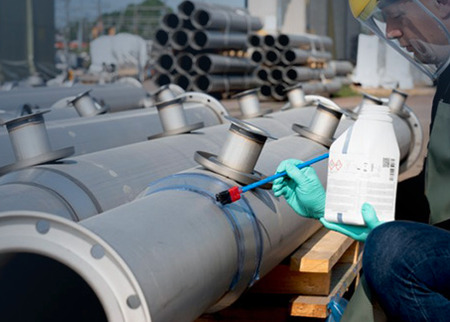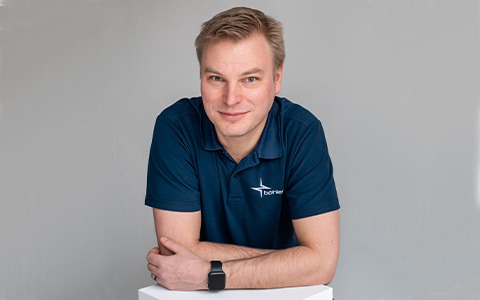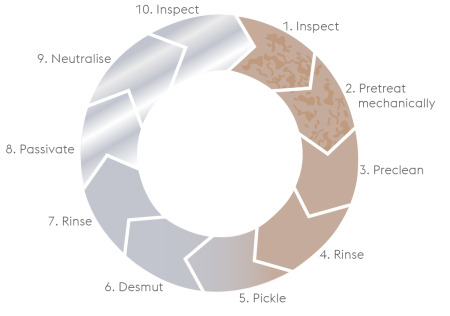Perfectly cleaned stainless steel welds with Finishing Chemicals

We sat down with Wolfgang Schlattl, VP Global Business Development Finishing Chemicals, and André Fasth, Managing Director of our Finishing Chemicals factory in Malmö, Sweden, to talk about the benefits of using finishing chemicals to clean stainless steel welds and components. Read the full interview and find out more!
After welding stainless steel, cleaning the weld seam is crucial to protect it from corrosion. Stainless steel surfaces are vulnerable during manufacturing processes such as cutting, forming, welding and even storage.
These operations often result in surface defects that, if not properly cleaned or pickled, can lead to corrosion. One of the most significant problems is the formation of heat oxides during welding, which weaken the corrosion resistance of the material.
Would you tell us a little bit more about the passive layer on stainless steel?
Stainless steel is protected by a thin layer of oxide called the "passive layer". This passive layer refers to the self-healing properties of the metal. It forms automatically when the chromium in the stainless steel is exposed to oxidising elements such as oxygen.
Think of it like this: Iron oxide causes rust, while chromium oxide forms a protective passive layer that protects the metal from corrosion. However, the passive layer can only form if the surface is free of contaminants. That's why proper cleaning is so important - it ensures the surface is clean enough for the passive layer to form and protect the metal.
André, what are the main methods of post-weld surface treatment?
There are both mechanical and chemical cleaning methods for post-weld treatment.
Mechanical cleaning includes grinding, blasting and brushing. Grinding removes weld slag, deep scratches, heat oxides and the chromium depleted layer. The quality of the surface depends on the fineness of the grit: the finer the grit, the smoother the finish.
Blasting is similar in that it removes slag and heat oxides, but it doesn't remove the chromium depleted zone. The result really depends on the abrasive, the size of the particles and the pressure used. It gives the surface a nice uniform look, but it can sometimes add compressive stress. For brushing, we use stainless steel brushes or Scotch Brite, which are great for removing heat oxides and slag efficiently.
What are the cleaning methods when we talk about chemical cleaning and passivation? Could you explain this in more detail?
Pickling removes surface impurities by etching the surface in a controlled manner, thereby restoring the corrosion resistance of stainless steel. It is the most efficient way to remove heat oxides, chromium depleted zones and other impurities, especially on large surfaces.
Passivation is carried out in a similar way to pickling. The passivator, applied by dipping or spraying, strengthens the passivation layer. As the passivator also removes free iron impurities from the surface, the treatment is more important after mechanical cleaning and operations durring which there is a risk of iron contamination. For this reason, the process can also be called decontamination.
André, in your experience, what is the best and most efficient cleaning process after stainless steel processing?
A study funded by the European Commission (2012-2016) provided a best practice guideline for the post-weld cleaning of stainless steel, specifically aimed at preventing future corrosion. The result was clear: Pickling is the most effective method of cleaning welds to ensure corrosion resistance.
Mechanical cleaning methods alone, such as grinding or blasting, proved insufficient in removing the anodic activity that forms in the heat affected zones. The most effective approach was a combination of brushing followed by pickling, which consistently resulted in higher CPT (Critical Pitting Temperature) values as measured by the SVET technique.
Wolfgang, could you highlight the main conclusions for us again?
Only by pickling can complete corrosion resistance of the weld be guaranteed. This means that mechanical processes alone are not sufficient. Pickling is the most efficient method for cleaning large surfaces. In addition, pickling produces a uniform and homogeneous surface that ensures a durable and corrosion-resistant finish. Passivation also removes ferrous contaminants. It is an important choice after mechanical cleaning to properly restore the passivation layer.
Interview guests
Wolfgang Schlattl, VP Business Development Finishing Chemicals

André Fasth, CEO of Finishing Chemicals plant in Malmö
Find out more about the cleaning processes and the perfectly suited products from voestalpine Böhler Welding.




